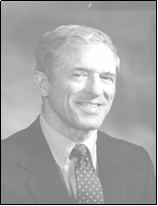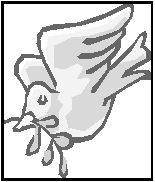|

FEBRUARY MEETING
"Brunelleschi's Ospedale degli
Innocenti - the First Foundling Hospital"
|
| Presenter Larry Kahn, M.D.
Dr. Lawrence Kahn will speak on Florence’s famous Ospedale
degli Innocenti the first commission of Filippo Brunelleschi, the
extraordinary fifteenth century architect and engineer. The earliest example
of Italian Renaissance architecture, the Ospedale is a model of architectural
elegance, grace, and beauty and has served as inspiration for countless
structures including our own Soulard Market. But, the Ospedale’s function
as a foundling hospital is equally remarkable; for over 600 years it has
provided care for children - the longest continuous history of any known
such institution. The Ospedale’s loggia has a special significance for
American pediatricians - for one of the della Robbia sculpted bambini that
adorn its facade became the insignia of the American Academy of Pediatrics.
This building represents a significant social and cultural landmark of
humanism during the "quattrocento".
Lawrence Kahn, M.D. is a retired pediatrician. Trained
at St. Louis Children's Hospital, he engaged in the private practice of
pediatrics in St. Louis for close to twenty years and then became a member
of the full time pediatric faculty at Washington University School of Medicine.
Currently his major activity is with the Lifelong Learning Institute of
Washington University, an organization for seniors engaged in pursuing
their intellectual interests.
|
|
Next Meeting Wednesday, April 16, 2003
Cocktails 6:30 PM - Dinner 7:00 PM
Da Baldo's Restaurant
RSVP Marie Cuccia-Brand
(314) 993-2252
or by email
|

RECAP OF JANUARY MEETING
Lyon: A Roman City
|
| presented by Salvatore Sutera, Ph.D.
 Due
to its being destroyed and deeply covered over, it took centuries to piece
together the puzzle of the location and physical make-up of the second
greatest city of the Roman Empire, Lugdunum ( modern Lyon), which reached
its zenith during the Pax Romana (69-192 AD ). The difficult process
of investigation, resulting in this exciting discovery, is clearly disclosed
in the illuminating book, “Lyon the Mirror of Rome,” written by the preeminent
archeologist, Amable Audin. Using this book as his main source, Dr. Salvatore
Sutera, Professor of Biomedical Engineering at Washington University, and
who as a Fulbright fellow taught at the University of Paris, gave a very
lucid talk, illustrated with slides, on this intriguing subject. Due
to its being destroyed and deeply covered over, it took centuries to piece
together the puzzle of the location and physical make-up of the second
greatest city of the Roman Empire, Lugdunum ( modern Lyon), which reached
its zenith during the Pax Romana (69-192 AD ). The difficult process
of investigation, resulting in this exciting discovery, is clearly disclosed
in the illuminating book, “Lyon the Mirror of Rome,” written by the preeminent
archeologist, Amable Audin. Using this book as his main source, Dr. Salvatore
Sutera, Professor of Biomedical Engineering at Washington University, and
who as a Fulbright fellow taught at the University of Paris, gave a very
lucid talk, illustrated with slides, on this intriguing subject.
Modern Lyon is situated at the confluence of two major
rivers, the Rhône and the Saône, located about 350 km southeast
of Paris. Prior to the Roman invasion there was an important Celtic trading
center on the low land of the peninsula.
The conquest of Gaul (modern France) was completed by Julius Caesar’s
army in 50 BC, after suppressing the Celtic tribes and expelling the Germanic
invaders.
In 43 BC the Roman General Plancus, co-governor of the
province of Gaul, established the new city of Lugdunum, on the high ground,
on what is now Fourvier? Hill and the Sarra Plateau where Caesar had earlier
established his military base. Lugdunum derives from Lougdounos, named
by the Celts after one of their gods. Roman engineers outlined the
city’s boundary, defined its circumference, and determined directional
axes with the aid of a special instrument called the “groma.” As a result
of the earlier further applications of this engineering technique, surveyors,
already knowing the year (43 BC) when the city was laid out, were able
to work out the exact day, October 9, that Lugdunum was founded.
In 16 BC Emperor Augustus mandated that Lugdunum be made
the capital of the “Three Gauls”-the region’s west, north, and east quadrants
- and construction, which included a theatre, forum, market, and palace
was begun.
Four great aqueducts to transport water to the high ground
were built under Emperor Claudius, a native son of Lugdunum. Other
new structures were constructed under the Antonini dynasty of seven emperors.
These included Hadrian and Marcus Aurelius. Consequently, a “metropolis”
came into being.
Adjacent to the monumental buildings were the quarters
for the common people, similar to those in Pompeii and Herculaneum, with
shops on the street level and living quarters above, and streets with high
curbs to carry storm water and to keep vehicles confined to the streets.
Magnificent villas had beautifully decorated mosaic floors, one of which
can be seen, still in its exact location, in the Subterranean Museum.
The amphitheatre of the three Gauls, the oldest (19 AD) in Gaul, is
a sacred site for all Christians due to the persecution of Christians in
Lugdunum, under Marcus Aurelius, and of the torture and killing of Sainte
Blandine in 177 AD.
Two notable findings which enabled archeologists to pinpoint
the site of these slayings, were a preserved letter written in 177 by surviving
Christians of Lugdunum to fellow Christians in Asia Minor describing these
events; and the Claudian Tablet, a bronze plaque containing a speech by
Emperor Claudius to the Roman Senate in 48 AD, calling for citizenship
for the Gauls.
This plaque, was placed in the Federal Sanctuary, close
to the amphitheatre, but torn down in the 12th century. Parts of the plaque
were discovered in 1528 on the peninsula. Also found was a sign dedicating
the amphitheatre to Emperor Tiberius Subsequent searching uncovered
the amphitheatre buried under the botanical gardens. .
Caracalla, who became emperor in 221, and who granted
citizenship to all the free people of the empire, was the last Roman emperor
As Lugdunum went downhill at the end of the second century,
a savage battle, caused by imperial power struggle, was fought at Lugdunum.
Seven years later, after the Gauls revolted and raiders, in effect, halted
the water supply by stealing the lead from the aqueducts, the residents
were forced to move to an island in the confluence, establishing a new
Lugdunum.
From then on and into the middle ages the cut stone of
the buildings on Fourvier? Hill and the Sarra Plain was cannibalized.
Lyon grew on the subterranean foundation of the city of Lugdunum.
Summary by Dorotea Rossomanno-Phillips
|
|

L'ANGOLO DEL PRESIDENTE
By James Tognoni
|
My Fellow Members,
After a long and tough winter the signs of spring are beginning
to show. Our March meeting was well attended; the highlights were the St.
Joseph’s bread and the legend behind the Fava bean. Thanks to Marianne
Peri Sack for doing this for us. Additionally, the very interesting presentation
by member, Sal Sutera.
At our April meeting, Dr. Larry Kahn will be our presenter.
We will also honor two students from Washington University with the Fred
Giacomo Award given by Southwest Bank and the Frank LoPiccolo and Mario
Pertici Award given by the Italian Club. These awards recognize these
exemplary students with financial assistance for their study this summer
in Arezzo, Italy.
Annually, at its June meeting, the Club presents
its Italian Heritage Award to an individual who has distinguished him or
herself through unselfish community service. Please contact a member of
our Board with your nominations. We ask that you include a brief
explanation giving the reasons why you think the person should receive
the award.
In the coming months we have many exciting programs for
you and look forward to seeing you there. Bring your family, friends
and other guests. We are always pleased to have a full house.
As I mentioned during the March meeting your officers and
board members have been working to bring refinements to various areas of
our organization. We want to make sure that all members feel included
and part of the ICSL family. The board is planning a half-day working
session on a Saturday afternoon within the next few weeks. At this meeting
we hope to further define and refine the Clubs’ by-laws, put the final
touches on committee responsibilities and other organizational issues.
I will close for now and hope to see many of you at the April meeting.
Remember to call and make your reservation!!! May the coming of Easter
allow you spend time with loved ones. I love this time of year. Everything
feels new, fresh and the spirit rejuvenated.
Buona Pasqua, Jim
jtognoni@earthlink.net

|
Congratulations to Dr. Rebecca
Messbarger!
|
| Introduction by Eugene Mariani
"Congratulations to Dr. Rebecca Messbarger on her recent
attainment of tenure at Washington University and on the publication of
her book "The Century of Women: Representations of Women in Eighteenth-Century
Italian Public Discourse". The book discusses five 18th-century Italian
texts by male and female authors whose leit-motifs are women: they include
an academic debate, a scientific tract, an oration, an Enlightenment journal
and a fashion magazine. The Italian Cultural Institute of Chicago nominated
the book for the International Flaiano Prize that is awarded by the Ministry
of Italian Culture.
Dr. Messbarger, who is an assistant professor of Italian,
has given several interesting presentations to the Italian Club."
submitted by Barbara Klein
|
|

Prossime Manifestazioni
Future Italian Club Meetings
|
April 16- "Brunelleschi's Ospedale degli Innocenti - the First
Foundling Hospital", presenter Larry Kahn, M.D.
Presentation of the Awards to the Washington University students
in Italian language
May 21- "Smartness and Beauty: Italian Medicine from the Renaissance
through the Eighteenth Century", presenter Lilla Vekerdy, Washington
University School of Medicine
June 18- “Annual Report from the Vice Consul of Italy in St. Louis”,
presenter Joseph Colagiovanni, Esq.
Presentation of the Italian Heritage Award
July 16- “Italian Cookies and Biscotti”, presenter Joann Arpiani |
Spring 2003 - Classic Italian Films
and Great Operas
|

April 25- L’Elisir D’Amore
In this lavish production of Gaetano Donizetti’s amusing and melodic
opera, audiences are entertained with such show-stopping arias as “Una
Furtiva Lacrima,” and “Quanto e’Cara, Quanto e’ bella.” Nemorino
is duped by a charlatan traveling salesman into buying his “love-potion,”
in order to win the heart of the lovely Adina. (2 hours, 9 minutes)
Friday, May 9- Pane e Tulipani
In this contemporary comedy by Silvio Soldini, housewife Rosalba, bored
with her life, takes a sudden opportunity for freedom when she is unexpectedly
separated from everyone during a one day trip. The beauty of Venice,
together with her new-found freedom lead her to romance and self-discovery.
(l hour, 40 minutes)
Friday, May 16- La Cenerentola
Gioacchino Rossini’s delightful, sparkling, comic opera of the fairy
tale, Cinderella, is full of bubbling fun, wit, speed, and grace.
Cinderella, goodness personified, is a perfect foil for her two stupid,
vain, and cruel stepsisters. The distinguished cast more than fulfill
the vocal demands of the music. (2 hours, 44 minutes)
|
|
The Italian Club of St. Louis
|
|
|
|


by Carol Mondia
PASQUA

La stagione di Pasqua significa due avvenimenti. La festa di
Pasqua annunciava l’arrivo di primavera. Naque come motivo di ringraziamento
e offerte per la future piantagione. I Persiani perfino mangiavano
le uova di gallina.
Soltanto nel secondo secolo giunse il rito di festeggiare la resurrezione
di Gesu’. Siccome volevano un simbolo di rinascimento hanno scelto
questo periodo. I cristiani credono che Gesu’. Era mandato
dal Signore per partecipare nel grande sacrificio (dando la Sua Vita) per
la redenzione dei pecati del’uomo. La resurrezione realizza la teoria
pagana che aspettavano la rinascita dopo un invero desolato e morto.
Dopo le funzioni religiose benedivono le uova e distribuivano alla congregazione.
“Inizialmente, nella Bibbia, la Pasqua indicava l’agnello immolato dagli
Israeliti in Egitto; essi avevano messo il suo sangue sugli stipiti e sull’architrave
delle porte a avevano mangiato la sua carne. Grazie a questo sacrificio
l’angelo distruttore era passato oltre gli Israeliti senza far loro del
male.” Se uno ricorda Cristo vien chiamato “agnello” ed era sacrificato.
La parola “Pasqua” viene dal verbo ebraico Pèsach che significava
passare oltre, proteggere o salvare. Per I cristiani questo e’ il
significato di Pasqua.
Assieme ai cristiani gli ebrei festeggiono questo periodo (ovviamente
con diverse idee). Gli ebrei ricordano la fuga e la liberazione dall’Egito.
Pesach!
“Per quanto riguarda le tradizioni pasquali, oggi, come allora ritroviamo
sulle tavole I segni del ringraziamento verso la natura, mescolati a simboli
religiosi che ricordano gli eventi principali del Cristianesimo.
La presenza del pane sulla tavola ha significato votivo, nel ricordo della
discendenza dal sovrannaturale, prodigio della germinazione del grano,
ricordo del pane azzimo (il pane senza lievito consumato dalgi Ebrei in
occasione della fuga dall’Egitto). L’uovo fa parte integrante
della ricorrenza, un auspicio di fecondità).
Sulla tavola italiana, oltre le uova e pane, si trovano torte salate,
torte verdi, la torta pasqualina, antico piatto genovese, la torta di Pasqua
al formaggio di origine umbra, la crescia di Pasqua merchigiana e le pizza
al formaggio campane ripiene di uova, percorino, farina e olio d’oliva,
gli “aceddi cu l’ova” siciliani.
Diversi luoghi hanno diversi dolci e pasti. A Campania, per esempio,
mangiano la pastiera, un dolce napolitano che consiste di grano ammollato
cotto in latte e zucchero, a base di ricotta, uova, latte, essenza di fiori
d’arancio. Torta Pasquale viene dalla Sicilia. Pizza di Pasqua
viene da Mugello e da Civitavecchia. Un pane dolce “la colomba” origine
lombarda e’ mangiato in tutta Italia.
Alla prossima,
Carolina
BUONA PASQUA
|

|
|